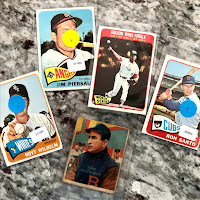Cornelius Alexander Mack
Philadelphia Athletics
Manager
Born: December 22, 1862, East Brookfield, MA
Major League Teams: Washington Nationals 1886-1889; Buffalo Bisons 1890; Pittsburgh Pirates 1891-1896
World Series Appearances: XX
As a Manager: Pittsburgh Pirates 1894-1896; Philadelphia Athletics 1901-1950
Died: February 8, 1956, Philadelphia, PA (93)
Hall of Fame Induction: 1937
Connie Mack had a decent playing career as an above-average defensive catcher for 11 seasons, appearing in 724 games and batting .244 with five home runs. He led the league twice in runners caught stealing (1890 and 1892) and was one of the most regularly used backstops of the late 1890s. After his playing career was over, Mack embarked on a 53-year odyssey as a big league manager, with 50 of those seasons spent with the Philadelphia Athletics. He's the longest serving manager in Major League Baseball history with his tallies for wins (3,731), losses (3,948) and overall games managed (7,755) not likely to ever be surpassed. Mack won World Series titles with his Athletics in 1910, 1911, 1913, 1929 and 1930, and he won the American League pennant nine times. As part-owner of the Athletics, he was constantly battling financial troubles which led to the selling off and rebuilding of the team several times throughout his 50 years at the helm.
Mack, known as "the Tall Tactician" is best known for wearing a full suit and usual a hat in the dugout, scorecard ever at the ready. He created a code of conduct for his teams and according to baseball historian Bill James he looked for seven characteristics in his players - "physical ability, intelligence, courage, disposition, will power, general alertness and personal habits." He was inducted into the Baseball Hall of Fame in 1937, and then managed 13 more seasons. Nearing bankruptcy, Mack was forced to sell his team in November 1954, with Arnold Johnson being awarded the franchise for $1.5 million. Johnson promptly moved the team to Kansas City, and the Athletics sold their ballpark to the Phillies. the ballpark, originally called Shibe Park, had been renamed Connie Mack Stadium in 1953. Mack, along with Robin Roberts, was in the inaugural class of inductees to the Philadelphia Baseball Wall of Fame in 1978 and a statute of the former Athletics manager still stands outside the entrance of Citizens Bank Park.
Building the Set
December 16, 2020 from Albion, NY
Within days of officially deciding to collect the Diamond Stars set, I found myself searching for the 1993 extension set consisting of 36 more "what if" cards this time issued by the Chicle Fantasy Company. Individual cards from this set are very prevalent on eBay, but I wanted to buy a complete set to save myself some time and money. Given this is a relatively modern set, I was somewhat surprised at the closing auction prices for previously sold complete sets and I was happy to win my set at a lower price. These cards are gorgeous, and I can tell a lot of hard work and love for the originals went into making this tribute set. What's more, the set's creators were smart enough to start the numbering with card #120, given the 1981 extension set had left off with #120.
As I slowly collect the originals from the 1930s, I'll also highlight each of the cards from these extension sets with their own posts.
Variations Available
1 - 1993 / blue back / no statistics / 1993 copyright
The Card / Athletics Team Set
This is actually the first card of Mack's in my collection and it's a welcome addition. A quick story on the origin of the Athletics' elephant logo in case you've not heard it before. In 1905, New York Giants manager John McGraw remarked that Mack's team had "a big white elephant on his hands," implying no one else wanted any of their players. Mack, showing he had a sense of humor and a slightly ornery side, adopted the white elephant as an unofficial logo and the team still uses it today. As I compose this post, news emerged this week the Athletics are again exploring a potential move with Las Vegas mentioned as a possible landing site. The team spent only 13 seasons in Kansas City (1955-1967) before moving to Oakland in 1968.
1936 Season
Mack's Athletics were awful, going 53-100 and finishing dead last in the American League. This was during one of their many rebuilding periods and they wouldn't have a winning record again until 1947. Harry Kelley was their top pitcher, going 15-12 with a 3.86 ERA over 35 appearances. Wally Moses led the team in hitting with a .345 average while Bob Johnson (#138) led the team in home runs (25) and RBIs (121).
|
|
|
|
|
|
Other Notable Baseball Cards
First Mainstream Card: 1887-90 Old Judge (N172) - 4 different variations
Topps Flagship Set Appearances (0): N/A
Most Recent Mainstream Card: 2014 Panini Golden Age #31
256 - Mack non-parallel baseball cards in the Beckett online database as of 5/17/21.
Sources:
Previous Card: #141 Fred Lindstrom - Brooklyn Dodgers
Next Card: #143 Joe McCarthy MG - New York Yankees





































